COVER STORY:
Afghan Treasures: Asian Art Museum Exhibit
The Asian Art Museum is the only West Coast venue for a breathtaking exhibit of Afghan artifacts — some 228 objects ranging in date from 2200 BCE to the second century CE, from the National Museum, Kabul. A Siliconeer report.
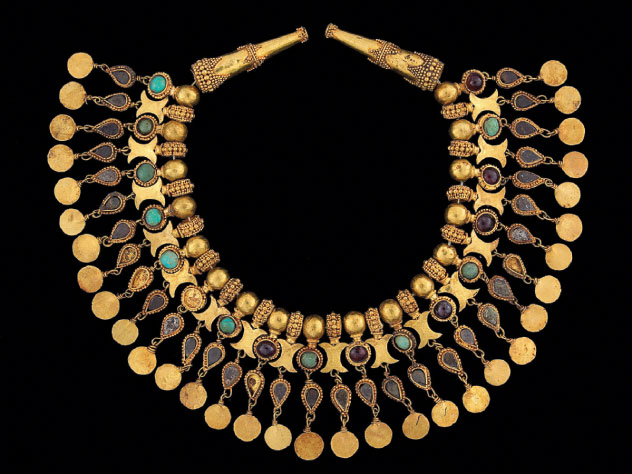
(Above): Ornament for the neck of a robe, Tillya tepe, 1st century B.C. to 1st century A.D. Found in the grave of a young woman, this elaborate necklace is noteworthy for its sophisticated design and use of polychromy. In typical nomadic fashion, it was sewn to her garment, with the thread passing through small gold tubes soldered to the backs of individual ornaments. Gold, turquoise, garnet, and pyrite. National Museum of Afghanistan. [THIERRY OLLIVIER / MUSÉE GUIMET photo]
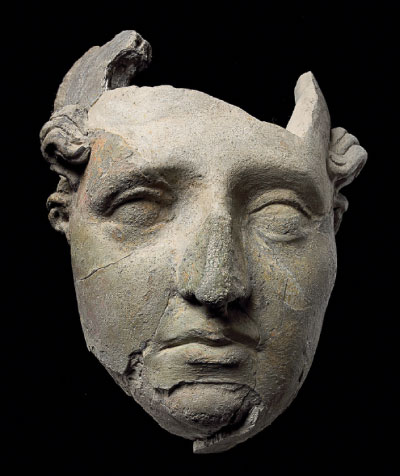 (Right): COVER PHOTO: Male or female head made of unfired clay, dating from the second century B.C., from the site of the former Greek city Aï Khanum in a region of Afghanistan that was conquered by Alexander the Great. National Museum of Afghanistan. (THIERRY OLLIVIER / MUSÉE GUIMET) (Right): COVER PHOTO: Male or female head made of unfired clay, dating from the second century B.C., from the site of the former Greek city Aï Khanum in a region of Afghanistan that was conquered by Alexander the Great. National Museum of Afghanistan. (THIERRY OLLIVIER / MUSÉE GUIMET)
There is more to Afghanistan than war, sectarian strife and medieval values. And the proof is in plain sight for San Francisco Bay Area museum enthusiasts, thanks to the Asian Arts museum.
“Extraordinary artifacts uncovered in modern-day Afghanistan, long thought stolen or destroyed during some twenty-five years of conflict until the dramatic announcement of their existence in 2003,” made their only West Coast appearance on their United States tour at the Asian Art Museum of San Francisco Oct. 24, 2008, through Jan. 25, 2009, the museum said in a statement.
“Seven years ago, with the Taliban roaming our streets, none of us could have imagined that Afghanistan would be able to recover and celebrate its rich history,” said Afghanistan’s ambassador to the U.S. Said Tayeb Jawad. “Today, Afghanistan is once again regaining its historic role in bridging cultures, countries, and civilizations. This exhibition presents a country of long history, rich heritage, breathtaking beauty, and dynamic trade and commerce. The treasures on display speak to Afghanistan’s ancient history and its present-day challenges while showcasing the sacrifices of our people to protect and preserve our heritage. I hope that my fellow Afghans in the Bay Area come see the exhibit and celebrate the future of hope that these recovered ancient artifacts represent.”
Revealing the multicultural heritage of Afghanistan — once the heart of the Silk Road linking cultures from Asia to the Mediterranean — are some 228 objects ranging in date from 2200 BCE to the second century CE.
The artworks are mainly drawn from three archaeological sites, together with a few earlier works providing background. These artworks which belong to the National Museum, Kabul, include fragmentary gold bowls with artistic links to the cultures of ancient Mesopotamia (largely present-day Iraq) and the Indus valley (largely present-day Pakistan) from the Bronze Age site of Tepe Fullol; bronze and stone sculptures and a gilded silver plaque from the former Greek colony at Ai Khanum (“Lady Moon”); bronzes, ivories, and painted glassware that had been imported from Roman Egypt, China, and India, and excavated from ancient storerooms discovered in the 1930s and 1940s in Begram; and more than one hundred gold ornaments from the “Bactrian Hoard,” found in 1978 in Tillya Tepe, the site of six nomad graves, which reveal a synthesis of Greek, Roman, Persian, Indian, Chinese, and Siberian styles.
“This exhibition is the culmination of many years of work by the Afghans. Without their courage and commitment, these objects would not exist today,” said Fredrik Hiebert, exhibition curator and National Geographic Archaeology Fellow. “Having worked closely with Afghan officials since 2003 on the preservation and inventory of the objects, I am honored to be part of the effort to share these treasures with audiences in the United States and ultimately to enhance the understanding of Afghanistan’s rich cultural heritage.”
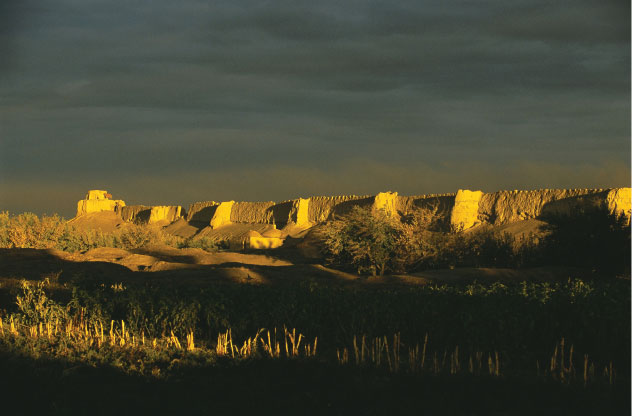
(Above): Balkh, the major city of ancient Bactria, at the foot of the central highlands in northern Afghanistan, is said to have been home to legendary prophet Zoroaster, residing here centuries before the arrival of Alexander the Great. [KENNETH GARRETT / NATIONAL GEOGRAPHIC photo]
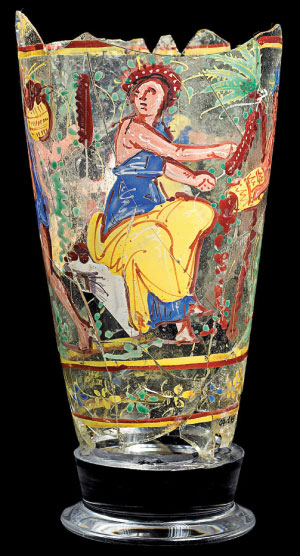 (Right): Painted beaker (Begram, Room 10), 1st century A.D. Glass. National Museum of Afghanistan. [THIERRY OLLIVIER / MUSÉE GUIMET photo] (Right): Painted beaker (Begram, Room 10), 1st century A.D. Glass. National Museum of Afghanistan. [THIERRY OLLIVIER / MUSÉE GUIMET photo]
Exhibit Layout
The exhibition begins in North Court with a brief introduction and a new map of modern Afghanistan created by National Geographic, which highlights the archaeological sites featured in the show. Specially commissioned maps will be on display throughout the exhibition.
Lee Gallery offers a further introduction by acting as a screening room for a 12-minute version of the documentary Afghanistan: Hidden Treasures from the National Museum, Kabul (National Geographic, 2008, 28 mins.) narrated by Khaled Hosseini, author of The Kite Runner and A Thousand Splendid Suns. It features footage of the 2004 recovery of the collections of the National Museum, Kabul, which had been hidden in the vaults of the Central Bank in the Presidential Palace by a group of selfless Afghan heroes.
Organized by archeological site, the exhibition artworks begin in the Hambrecht Gallery with a small number of objects from Tepe Fullol in northern Afghanistan. In 1966, farmers near the Afghan village of Fullol discovered the first evidence of a Bronze Age civilization in the region. Gold from the nearby Amu Darya riverbed most likely provided the gold for several bowls—part of a burial cache—found at the site, including a fragment of a bowl depicting bearded bulls dating from 2200 to 1900 BCE.
The main group of artifacts in Hambrecht Gallery comes from the site of the former Greek city of Ai Khanum in a region that had been conquered by Alexander the Great. These artifacts reflect the Mediterranean influence in the area between the fourth and second centuries BCE. The works include Corinthian capitals from before 145 BCE. A similar capital was shown to the late Afghan King Zahir Shah on a hunting expedition in the region in 1961, leading to the discovery of the site. Objects in this room also include bronze casts and limestone carvings representing Greek figures, as well as sundials, architectural ornaments, and vessels of the Greek style.
One of the oldest artifacts found is a ceremonial plaque made of gilded silver depicting Cybele, the Greek goddess of nature presiding within an orderly cosmos. There will be a digital reconstruction of the city of Aï Khanum as well as a site map.
Items of trade from the third site, at Begram, date from between the first and second centuries CE. Elaborately carved Indian ivory reliefs and figurines used as decorative elements on furniture will be digitally reconstructed and shown on a monitor in the gallery with a site map of Begram. A painted goblet depicting figures harvesting dates and a bronze mask of Silenus, a wine deity, are just a few of the artifacts discovered that shed light on the role of Afghanistan in the network of trade along the Silk Road. A portion of the Begram artifacts appear in the Hambrecht Gallery with the remainder showcased in the Osher Gallery.
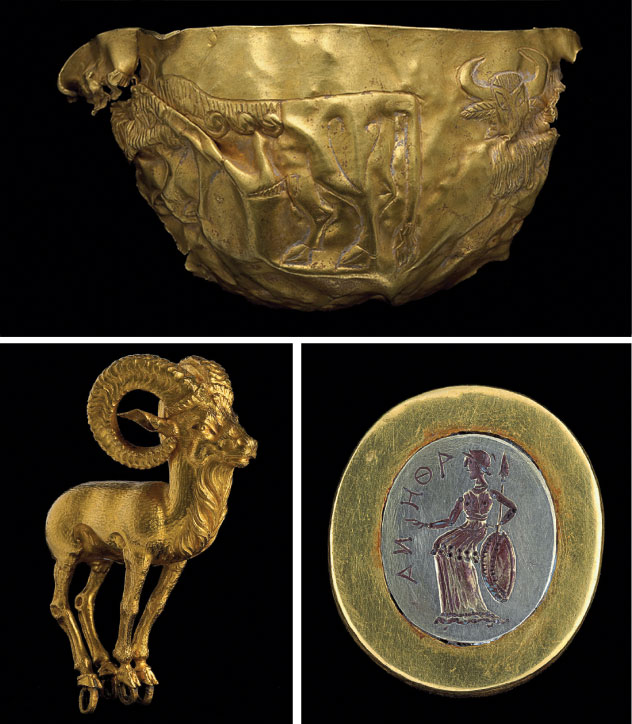
(Above, top): Fragment of a gold bowl with Mesopotamian motifs, dating from the Bronze Age (2500 B.C.), discovered at Tepe Fullol in northern Afghanistan. 2200-1900 BC. Gold. National Museum of Afghanistan. (Bottom, left): Ornament in the form of a ram, Tillya tepe, 1st century B.C. to 1st century A.D. The animal appears to be keeping watch, standing erect and looking straight ahead. The rings beneath the ram’s hooves allowed this ornament to be attached to the high headdress often seen among nomads. Gold. National Museum of Afghanistan. (Bottom, right): Ring depicting Athena, Tillya tepe, 1st century B.C. to 1st century A.D. The name of Athena is engraved in Greek letters written backwards, indicating that the central part of this ring was intended as a seal. As a patron deity of war, Athena is shown wearing a helmet and holding a spear and shield. The Greek goddess was popular among nomads, probably because of her warlike nature. Yellow and white gold. National Museum of Afghanistan. [THIERRY OLLIVIER / MUSÉE GUIMET photos]
The fourth group consists of some 100 gold objects dating from the first century BCE to the first century CE. On display in the Osher Gallery, these artworks were among those discovered in 1978 by a Soviet-Afghan team led by Viktor Sarianidi at Tillya Tepe in northern Afghanistan. The site contained jewelry and gold ornaments from the graves of six Central Asian nomadic people.. The graves contained thousands of gold objects sewn onto the burial shrouds and clothing of the deceased. On view will be an exquisite crown, as well as necklaces, belts, rings, and headdresses—most made of solid gold with insets of semiprecious stones such as turquoise and garnets. Many of the Bactrian objects reflect local artisans’ distinctive blend of motifs known from Greek, Roman, Indian, and Chinese art.
After an initial tour through Paris, Turin, and Amsterdam, the exhibition was reorganized for the United States and accompanied by a new catalogue and a video documentary produced by National Geographic with narration by the celebrated author Khaled Hosseini. The exhibition began its national tour at the National Gallery of Art from May 25 through September 7, 2008. From the Asian Art Museum the exhibition will travel to the Museum of Fine Arts, Houston, February 22 through May 17, 2009; and The Metropolitan Museum of Art, New York, June 23 through September 20, 2009.
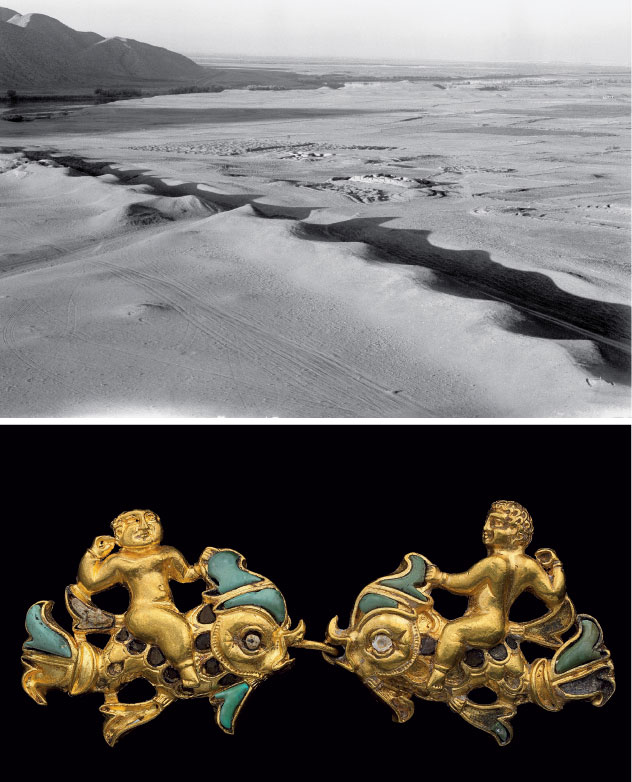
(Above, top): Aï Khanum. The end of the royal Greek city of Aï Khanum (meaning “Lady Moon”) came suddenly around 145 B.C. at the hands of nomads from the northeast, who set fire to the palace and robbed the treasury. [MUSÉE GUIMET / DAFA photo]
(Above, bottom): A pair of clasps. Cupids on dolphins. Second quarter of the 1st century AD. Gold, turquoise, mother of pearl. National Museum of Afghanistan. [THIERRY OLLIVIER / MUSÉE GUIMET photo]
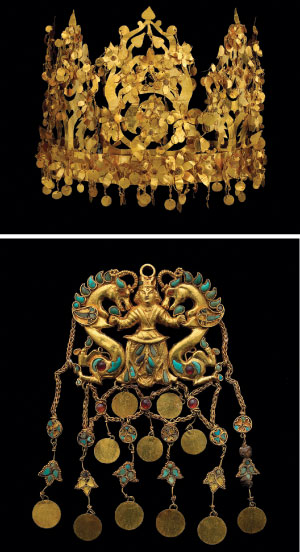 (Right, top): A folding crown from one of the six graves of Bactrian nomads discovered at Tillya Tepe in northern Afghanistan in 1978. The crown, dating from the first century A.D. and wrought of solid gold, was collapsible for easy transport by the ancient nomads. (Right, top): A folding crown from one of the six graves of Bactrian nomads discovered at Tillya Tepe in northern Afghanistan in 1978. The crown, dating from the first century A.D. and wrought of solid gold, was collapsible for easy transport by the ancient nomads.
Gold and imitation turquoise. National Museum of Afghanistan.
(Right, bottom): One of a pair of gold pendants showing the “Dragon Master,” from the second quarter of the first century A.D., found at Tillya Tepe in northern Afghanistan. Gold, turquoise, garnet, lapis lazuli, carnelian, and pearl. National Museum of Afghanistan. [THIERRY OLLIVIER / MUSÉE GUIMET photos]
Exhibition Organization
The exhibition was organized by the National Geographic Society and the National Gallery of Art, Washington, in association with the Asian Art Museum of San Francisco; the Museum of Fine Arts, Houston; and The Metropolitan Museum of Art, New York. This exhibition is supported by a generous grant from the National Endowment for the Humanities and an indemnity from the Federal Council on the Arts and the Humanities.
Afghanistan is free with general museum admission. However, due to the anticipated popularity of Afghanistan, we will be using a timed entry system for the exhibition. As such, museum admission tickets will be sold for specific dates and times during the run of the exhibition. Advance purchase of museum timed tickets is highly recommended. Tickets can be purchased online at www.asianart.org with a service charge of up to $2.25 per ticket. Tickets can be picked up at Will Call the day of the visit. Advance and day-of tickets are also available at the museum with no processing fee, subject to availability. Free admission on Target First Free Sundays is on a first-come, first-served basis. Due to capacity restrictions, admission is not guaranteed.
The Museum
The Asian Art Museum is a public institution holding more than 17,000 Asian art treasures spanning 6,000 years of history. The museum is one of the largest museums in the Western world devoted exclusively to Asian art. Once located in San Francisco’s Golden Gate Park, the museum now resides at its new, expanded facility at Civic Center Plaza. An architectural gem featuring a dynamic blend of beaux arts and modern design elements, the museum’s new home is the result of a dramatic transformation of San Francisco’s former main library building by renowned architect Gae Aulenti (designer of Paris’s Musée d’Orsay) into a showcase for the museum’s acclaimed collection and exhibitions.
Location: 200 Larkin Street, San Francisco, CA 94102.
Hours: The museum is open Tuesday through Sunday from 10:00 am to 5:00 pm, with extended hours until 9:00 pm every Thursday.
For more information, readers can call (415) 581-3500 or www.asianart.org.
|